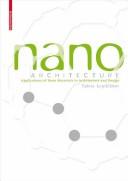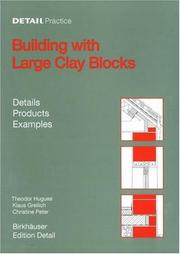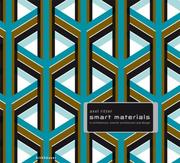
ISBN: 9783764379957 3764379952 3038214329 9786611951191 1281951196 3764383216 Year: 2008 Publisher: Basel : Birkhäuser,
Abstract | Keywords | Export | Availability | Bookmark
 Loading...
Loading...Choose an application
- Reference Manager
- EndNote
- RefWorks (Direct export to RefWorks)
Nanotechnologie gilt als eine der Schlüsseltechnologien des 21. Jahrhunderts mit stark wachsender wirtschaftlicher Bedeutung. In Architektur und Bauwesen liegen ihre heute nutzbaren Potenziale besonders in der Beschichtung von Oberflächen, die diesen funktionale Eigenschaften wie erhöhte Bruchfestigkeit, Fähigkeit zur Selbstreinigung, Feuerresistenz etc. verleiht. Auf Nanomaterialien basierende Zusatzstoffe machen gängige Materialien leichter, durchlässiger oder verschleißfester. Nicht nur für Fassaden und Dächer sind Nanomaterialien von großem Interesse, sondern sie bereichern auch die Gestaltungsmöglichkeiten von Innen- und Außenräumen. Nano-Dämmmaterialien eröffnen ökologisch ausgerichteten Architekten neue Potenziale.Architekten, Innenarchitekten und Designer finden in diesem Buch eine auf ihre Belange zugeschnittene Einführung in den naturwissenschaftlichen Hintergrund, eine kritische Diskussion der Vorzüge und Grenzen dieser Technologie und vor allem eine umfassende, mit zahlreichen internationalen Projektbeispielen belegte Darstellung von 16 bau- und designrelevanten Eigenschaften und Funktionen von Nanomaterialien. Nobelpreisträger Harold Kroto trug ein Vorwort bei.Dipl.-Ing. Innenarchitektin BDIA Sylvia Leydecker ist praktizierende Innenarchitektin mit dem eigenen Büro "100% interior" in Köln. Sie vertritt den BDIA in der Architektenkammer NRW, ist Dozentin bei mehreren Architektenkammer-Akademien, Mitglied im Kompetenzzentrum Nanotechnologie CC-NanoChem und im Institute of Nantechnology IoN, Schottland. Zahlreiche Vorträge und Zeitschriftenpublikationen über das Thema Nanotechnologie in Architektur, Innenarchitektur und Design. Nanotechnology is widely regarded as one of the twenty-first century's key technologies, and its economic importance is sharply on the rise. In architecture and the construction industry it has potentials that are already usable today, especially the coating of surfaces to lend them functional characteristics such as increased tensile strength, self-cleaning capacity, fire resistance, and others. Additives based on nanomaterials make common materials lighter, more permeable, and more resistant to wear. Nanomaterials are not only extremely useful for roofs and facades; they also expand design possibilities for interior and exterior rooms and spaces. Nano-insulating materials open up new possibilities for ecologically oriented architects.In this book, with a foreword by nobel prize winner Harold Kroto, architects, interior designers and designers will find an introduction to the scientific background specifically tailored to their needs, a critical discussion of the advantages and limits of the technology, and above all a comprehensive presentation of sixteen characteristics and functions of nanomaterials that are specially relevant for building and design, illustrated by numerous international project examples.Dipl.-Ing. interior designer BDIA Sylvia Leydecker is a practicing interior designer with her own firm in Cologne, 100% Interior. She represents the BDIA (Bund Deutscher Innenarchitekten, or Union of German Interior Architects/Designers) on the Architektenkammer Nordrhein-Westfalen (Chamber of Architects of North Rhine-Westphalia), serves as an instructor for a number of Architektenkammer academies, and is a member of the Kompetenzzentrum Nanotechnologie CC-NanoChem (Competence Center for Chemical Nanotechnology, or CC-NanoChem) and the Institute of Nanotechnology, or IoN, in Scotland. Numerous lectures and journal publications on the subject of nanotechnology in architecture, interior design, and design.
691 --- 691.9 --- 691.8 --- Nanotechnologie --- nanotechnologie --- bouwmaterialen --- interieurmaterialen --- designmaterialen --- 69.059.1 --- 691.175 --- 691.27 --- 699.81 --- 699.86 --- 72.039 --- 747 --- Bouwmaterialen (architectuur) --- Smart materials --- Synthetische materialen --- Kunststof --- smart materials --- Maintenance in general. Inspection. Cleaning --- Plastics --- Fibrous and foliate silicates --- Fire protection. Fireproofing of buildings. Firefighting installations and equipment --- Thermal insulation of buildings. Cold-resistant and heat-resistant construction. Expansion joints --- Hedendaagse architectuur. Bouwkunst sinds 1960 --- Interieurkunst. Binnenhuisarchitectuur --- Architecture and technology. --- Design and technology. --- Nanostructured materials. --- 747 Interieurkunst. Binnenhuisarchitectuur --- 72.039 Hedendaagse architectuur. Bouwkunst sinds 1960 --- 699.86 Thermal insulation of buildings. Cold-resistant and heat-resistant construction. Expansion joints --- 699.81 Fire protection. Fireproofing of buildings. Firefighting installations and equipment --- 691.27 Fibrous and foliate silicates --- 691.175 Plastics --- 69.059.1 Maintenance in general. Inspection. Cleaning --- Nanostructured materials --- Architecture and technology --- Design and technology --- Innovation --- Matériau --- Nanomaterials --- Nanometer materials --- Nanophase materials --- Nanostructure controlled materials --- Nanostructure materials --- Ultra-fine microstructure materials --- Microstructure --- Nanotechnology --- Technology and design --- Technology --- Technology and architecture

ISBN: 3038212938 3034614659 3764371110 129986371X 9783034614658 Year: 2004 Publisher: Basel De Gruyter
Abstract | Keywords | Export | Availability | Bookmark
 Loading...
Loading...Choose an application
- Reference Manager
- EndNote
- RefWorks (Direct export to RefWorks)
In modern masonry work it is customary to use large size blocks in building. They fulfil all the construction requirements even in singlelayer outside walls. Using two houses as examples all details are presented clearly and comprehensively in a scale of 1:10. In modern masonry work it is customary to use large size blocks in building. They fulfil all the construction requirements even in singlelayer outside walls. Using two houses as examples all details are presented clearly and comprehensively in a scale of 1:10. The authors elucidate on critical points, showing where care should be given to achieve convincing sustainable results.
Masonry. --- Building materials. Building technology --- building materials --- klei --- clay --- bouwmaterialen --- 691 --- 691.4 --- Bouwmaterialen ; baksteen ; grote kleiblokken --- 693.2 --- 693.2 Masonry of treated material, stones, blocks etc. --- Masonry of treated material, stones, blocks etc. --- 691.4 Earth. Cob. Clayware. Stoneware. Ceramic building materials --- Earth. Cob. Clayware. Stoneware. Ceramic building materials --- Bouwmaterialen (architectuur) --- Klei --- Bouwmaterialen ; leem, klei, aardewerk --- Maçonnerie --- Blocs en béton --- Constructions en argile --- Maçonnerie --- Masonry --- Building --- Foundations --- Walls --- Masonry of treated material, stones, blocks etc --- Blocs en béton. --- Constructions en argile. --- Maçonnerie. --- Blocs en béton. --- Maçonnerie.
Book
ISBN: 9783955532024 3955532038 9783955532031 395553202X 3955532046 Year: 2014 Publisher: München Institut für Internationale Architektur-Dokumentation GmbH & Co. KG
Abstract | Keywords | Export | Availability | Bookmark
 Loading...
Loading...Choose an application
- Reference Manager
- EndNote
- RefWorks (Direct export to RefWorks)
Glas prägt die Architektur, es bietet dem Architekten Möglichkeiten, mit Licht, mit der Beziehung "innen - außen" und dem Verhältnis des Menschen zum Raum und zur Natur zu spielen. Es dient der Steuerung von Licht und Wärme, von Raumatmosphären und Blickbeziehungen. Aber Glas braucht andere Materialien, die es halten, tragen, stützen und infolge dessen verlangt es einen integrativen Arbeitsansatz verschiedener Disziplinen: gute Glasarchitektur ist immer das Ergebnis eines gelungenen Zusammenspiels von Entwurf, Technik, Konstruktion und Umsetzung. Glas erscheint - je nach Zusammensetzung - transparent oder transluzent, farbig oder klar. Best of Detail: Glas bündelt die Highlights aus DETAIL und DETAILgreen zum Thema Glas, Transparenz und Transluzenz. Die Publikation setzt bei Grundsatzfragen an und bietet neben der theoretischen Basis mit einem umfangreichen Projektteil aus der Praxis jede Menge Inspirationen und konstruktive Lösungsbeispiele. Glass shapes architecture, offering architects scope for playing with the relationship between "inside and outside" and how people relate to space and nature. It influences interior light and warmth, offering special spatial atmospheres and views. Glass needs other materials to hold, carry and support it, so using it requires an integrative approach involving various disciplines. Good glass architecture is the result of a successful interaction between design, technology, construction and implementation. Depending on its composition, glass appears transparent or translucent, coloured or clear. Best of Detail: Glass combines highlights from DETAIL and DETAILgreen on the topic of glass, transparency and translucence. Starting with fundamental questions, the book offers a theoretical basis, details on many practically implemented projects, and plenty of inspiration and examples of successful structural solutions.
Glass construction --- Architecture, Modern --- Architecture --- -Details --- Matériaux --- Verre --- Construction --- 72.04 --- 691 --- 691.1 --- 691.6 --- 692.232 --- Bouwmaterialen ; glas --- Glasconstructies ; 21ste eeuw --- Glasgevels ; glasdaken --- Glass architecture --- Glass as structural material --- Glass in architecture --- Building --- Architectuurdetails --- Details (architectuur) --- Bouwmaterialen (architectuur) --- Glas --- Bouwmaterialen ; glas, vensterglas, spiegelglas --- Constructie-elementen van gebouwen ; buitenmuren ; bekleding --- Glass construction. --- Architectural details --- Buildings --- Details, Architectural --- Architectural design --- Architectural drawing --- Details. --- Details --- History --- -Construction en verre --- Transparence --- Vitrerie --- Architecture. --- Matériaux. --- Verre. --- Architecture, Modern - 21st century --- Architecture - - Details --- Construction en verre --- Matériaux. --- Matériaux --- -Glass construction
Book
ISBN: 9783035604580 9783035604603 3035604584 9783035604542 3035604541 3035604606 3035604592 Year: 2016 Publisher: Basel : Birkhaüser,
Abstract | Keywords | Export | Availability | Bookmark
 Loading...
Loading...Choose an application
- Reference Manager
- EndNote
- RefWorks (Direct export to RefWorks)
Typologically structured overview of 24 contemporary timber constructionsTimber: the old raw material and building material returns.There are many reasons today for building with wood and there are great advantages over conventional designs. Wood is not only a renewable building material that helps reduce the levels of CO2 and is hence good for climate change, but, due to modern computing and manufacturing processes, it can also be used for a variety of construction tasks. Wood possesses excellent qualities for both construction and indoor climate control, and can easily be combined with other common building materials.Based on 24 international projects, the book provides an overview of the range of possibilities in wood construction today. Texts, images, and plans document the architectural and constructive qualities of contemporary timber structures from the conceptual design to the structure in detail.The various uses are based on current research in modern timber engineering but also on timber construction expertise that has been developing over many centuries. This special discipline has evolved significantly in recent decades, particularly in Germany, Austria, and Switzerland, and is a world leader today.
Building materials. Building technology --- Architecture --- frame construction --- architecture [object genre] --- Building, Wooden --- Architecture, Modern --- 691 --- 691.1 --- 72.037 --- 691.11 --- 72.039 --- Houtarchitectuur ; 21ste eeuw --- Bouwmaterialen ; hout --- Building with wood --- Wood construction --- Wooden architecture --- Wooden building --- Building --- History --- Bouwmaterialen (architectuur) --- Houtconstructies --- Hout --- 21ste eeuw (architectuur) --- Eenentwintigste eeuw (architectuur) --- Architectuurgeschiedenis ; 2000 - 2050 --- Estructuras de madera --- Trabajos en madera --- Proyectos arquitctónicos --- Siglo XXI --- Libros electrónicos --- Constructions en bois --- Projets d'architecture --- Structure en bois --- Construction en bois --- Building, Wooden - History - 21st century --- Architecture, Modern - 21st century --- frame construction [wood frame construction]
Book
ISBN: 3035608652 9783035608656 303561024X 9783035608410 3035608415 9783035610246 Year: 2016 Publisher: Basel, Switzerland : Birkhäuser,
Abstract | Keywords | Export | Availability | Bookmark
 Loading...
Loading...Choose an application
- Reference Manager
- EndNote
- RefWorks (Direct export to RefWorks)
Although traditionally a building material of the warmer climate zones, bamboo is becoming increasingly popular amongst architects in the northern hemisphere; bamboo has several advantages - it is very stable, of low weight, and highly elastic, in addition to being readily available as well as renewable. The applications of bamboo in architecture have become significantly wider and diversified, so that today, even structures with large spans - such as bridges - are built with this material. The new and revised second edition of this manual provides a practical, systematic overview of the numerous potential applications and processing methods of this renewable material. The comprehensive presentation of groundbreaking bamboo buildings has been updated with more recent projects. Ein traditionelles Baumaterial der warmen Klimazonen Asiens und Lateinamerikas, erfreut sich Bambus eines wachsenden Interesses unter Architekten der nördlichen Hemisphäre: Bambus hat nicht nur ein geringes Gewicht bei großer Stabilität und ist ausgesprochen elastisch, sondern zeichnet sich auch durch Eigenschaften aus, die in Zeiten schwindender Ressourcen besonders gefragt sind: das Material ist reichlich verfügbar und zudem erneuerbar. Die Anwendungsbereiche von Bambus in der Architektur haben sich erheblich erweitert und diversifiziert, so dass heute sogar weitgespannte Konstruktionen wie Brücken daraus gebaut werden. Von diesen technischen und ästhetischen Möglichkeiten beeindruckt, nutzen auch Architekten in Europa, Nordamerika und Japan Bambus für vielfältige Bauaufgaben. In den letzten Jahren sind unter anderem private Wohnhäuser und Ausstellungspavillons aus Bambus entstanden, Überdachungen und sogar Schul- und Museumsgebäude. Die neue und überarbeitete 2. Auflage dieses Handbuchs bietet einen praxisorientierten systematischen Überblick über die zahlreichen Einsatzmöglichkeiten und Verarbeitungstechniken dieses nachwachsenden Materials. Die umfangreiche Präsentation von Bambusbauten wurde durch neuere Projekte aktualisiert.
Bamboo construction --- Sustainable architecture --- Bamboo --- Bamboos --- Bambusaceae --- Bambusoideae --- Grasses --- Eco-architecture --- Environmentally conscious architecture --- Environmentally friendly architecture --- Green architecture --- Green building design --- Green design (Buildings) --- Sustainable design (Buildings) --- Architecture --- Sustainable design --- Building, Bamboo --- Construction, Bamboo --- Structures, Bamboo --- Building --- Utilization --- 691.1 --- 691.12 --- Ecologische bouwmaterialen --- Bouwmaterialen; bamboe --- Architectuur; materialen --- bamboe --- bouwconstructie --- architectuur --- 691.1 Materials of organic origin --- Materials of organic origin --- Bouwmaterialen ; plantenstengels, stro, riet, bamboe --- Bamboe --- Bouwmaterialen --- Houtsoorten --- 693.2 --- Hout --- Houtproducten --- Travail du bambou --- Constructions en bambou --- Architecture durable --- Bambou --- Bois --- Construction --- Matériau végétal
Book
ISBN: 906832375X Year: 2000 Volume: *70 Publisher: Amsterdam Koninklijk Instituut voor de Tropen (KIT)
Abstract | Keywords | Export | Availability | Bookmark
 Loading...
Loading...Choose an application
- Reference Manager
- EndNote
- RefWorks (Direct export to RefWorks)
Geschiedenis en politiek - bevolking en samenleving - economie - cultuur en religie - natuur en milieu
Madagascar --- Geografie --- Landenreeks. --- Regional documentation --- reisgidsen (genre) --- Madagaskar ; reisgidsen --- Madagaskar --- Sociale aardrijkskunde --- Economische aardrijkskunde --- Politiek --- Geschiedenis --- Toerisme --- 908 <691> --- 282 Landbeschrijvingen (sociaal-economisch-cultureel) --- reisgidsen --- Madagaskar 994 --- Geneeskunde --- Techniek (wetenschap) --- Atlas --- Museum --- Maatschappij --- Film --- 982 --- geografie Afrika --- géographie Afrique --- Madagascar.

ISBN: 0910965544 1573879967 9781573879965 Year: 2001 Volume: v. 8 Publisher: Medford, N.J. : CyberAge Books,
Abstract | Keywords | Export | Availability | Bookmark
 Loading...
Loading...Choose an application
- Reference Manager
- EndNote
- RefWorks (Direct export to RefWorks)
#A0305A --- 691 Internet --- Business --- Electronic information resource searching. --- Electronic information resource searching --- Commerce - General --- Commerce --- Business & Economics --- Computer network resources. --- Computer network resources --- Computer searching --- Electronic searching --- Online searching --- Searching electronic information resources --- E-books --- Information retrieval
Book
ISBN: 1610447565 0871546639 9780871546630 9781610447560 9781610447560 Year: 2011 Publisher: New York : Russell Sage Foundation,
Abstract | Keywords | Export | Availability | Bookmark
 Loading...
Loading...Choose an application
- Reference Manager
- EndNote
- RefWorks (Direct export to RefWorks)
Labor market --- Wages --- Industrial relations --- Working class --- Work --- Industry (Psychology) --- Method of work --- Work, Method of --- Human behavior --- Labor --- Occupations --- Work-life balance --- 332.691 --- US / United States of America - USA - Verenigde Staten - Etats Unis --- Evolutie van de arbeidsmarkt
Book
ISBN: 9038912234 Year: 2001 Publisher: Rijswijk : Elmar,
Abstract | Keywords | Export | Availability | Bookmark
 Loading...
Loading...Choose an application
- Reference Manager
- EndNote
- RefWorks (Direct export to RefWorks)
#A0303A --- 691 Internet --- 001.891.32 --- 681.324 --- Databanken : zoekmethoden --- Internet : WWW-sites --- bibliografieën, zoekmethoden --- Web --- World Wibe Web --- Zoekmachines (Internet) --- gidsen --- Zoekmachines (Internet). --- gidsen. --- internet --- Computer architecture. Operating systems --- Internet ( computernetwerken ) --- 004 --- Internet --- WWW

ISBN: 376437327X 9783764373276 3764382279 9783764382278 1299864376 9781299864375 3764373261 9783764373269 Year: 2007 Publisher: Basel Boston Birkhäuser
Abstract | Keywords | Export | Availability | Bookmark
 Loading...
Loading...Choose an application
- Reference Manager
- EndNote
- RefWorks (Direct export to RefWorks)
Die Anwendung von Smart Materials in der Architektur ist ein innovatives, dynamisches Gebiet, in dem Forschung, Entwicklung und Anwendung im Bau fließend ineinander übergehen. Smart Materials mit ihren reversiblen Wechseleigenschaften reagieren auf Stimuli wie Licht, Temperatur und elektrisches Feld. Sie verändern sich dabei in Form, Farbe, Viskosität etc. Zu den faszinierendsten Entwicklungen gehören Formgedächtnis-Legierungen oder Phase Change Materials. Es lassen sich beispielsweise selbsttätig agierende kinetische Fassaden entwickeln oder auch Tapeten, die temperatur- und lichtabhängig Farbe und Muster verändern. Das Buch stellt einleitend die Entwicklung dieser Materialien sowie ihren Kontext in Architektur, Design und Kunst dar. Ein systematisch aufgebauter Überblick mit zahlreichen Details über Eigenschaften, Technologien, Produkte und Projekte wird anhand von rund zwanzig Materialgruppen gegeben. The use of smart materials in architecture is a dynamic and innovative area merging research, development, and use. Smart materials, with their reversible characteristics, respond to stimuli such as light, temperature, and electrical field by changing their form, color, viscosity, etc. One of the most fascinating developments is the advent of Phase Change Materials. These materials make it possible, for example, to develop self-acting, kinetic facades and wallpaper that changes its color and pattern based on temperature and light. The book presents the development of these materials and also describes their use in the contexts of architecture, design, and art. It offers a systematic overview with a detailed discussion of properties, technologies, products, and projects based on twenty groups of smart materials.
691 --- 691.8 --- 691.9 --- 691(035) --- 749.02 --- Architectuur industrieel design 21ste eeuw nieuwe materialen --- Smart materials --- 745.02 --- Axel Ritter --- architectuur --- bouwmaterialen --- design --- interieurvormgeving --- kunststoffen --- materiaalkunde --- materialen --- meubelkunst --- polymeren --- slimme materialen --- 688 --- 772.9 --- composieten --- glas --- metaal --- plastiek --- productdesign --- thermoharders --- thermoplasten --- titanium --- zonne --- zonneënergie --- Bouwmaterialen (architectuur) --- Kunststof --- Synthetische materialen --- Smart materials (design) --- Bouwmaterialen handboeken --- Meubelkunst en design technieken, materialen --- productdesign, afzonderlijke voorwerpen --- materials [matter] --- Innovation technologique --- Materiau intelligent --- Building materials. Building technology --- Architectuur ; industrieel design ; 21ste eeuw ; nieuwe materialen --- Bouwmaterialen ; handboeken --- Meubelkunst en design ; technieken, materialen --- Smart materials. --- Building materials. --- Architectural materials --- Architecture --- Building --- Building supplies --- Buildings --- Construction materials --- Structural materials --- Materials --- Adaptive materials --- Intelligent materials --- Sense-able materials --- Building materials --- Architecture intérieure --- Design --- Bouwmaterialen ; smart materials --- materials [substances]

 Search
Search Feedback
Feedback About
About Help
Help News
News